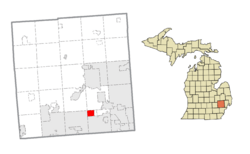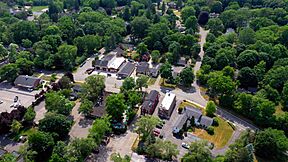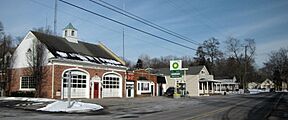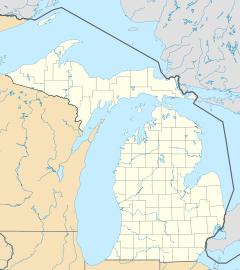Franklin, Michigan facts for kids
Quick facts for kids
Franklin, Michigan
|
|
|---|---|
|
Village
|
|
| Village of Franklin | |
|
Top-to-bottom: Downtown Franklin (2022), Franklin–Bingham Fire Department in (2013)
|
|
| Motto(s):
"Experience It"
|
|

Location within Oakland County
|
|
| Country | United States |
| State | Michigan |
| County | Oakland |
| Township | Southfield |
| Incorporated | 1953 |
| Area | |
| • Village | 2.66 sq mi (6.90 km2) |
| • Land | 2.66 sq mi (6.90 km2) |
| • Water | 0.00 sq mi (0.00 km2) |
| Elevation | 833 ft (254 m) |
| Population
(2020)
|
|
| • Village | 3,139 |
| • Density | 1,178.75/sq mi (455.08/km2) |
| • Metro | 4,296,250 (Metro Detroit) |
| Time zone | UTC-5 (Eastern (EST)) |
| • Summer (DST) | UTC-4 (EDT) |
| ZIP code(s) |
48025
|
| Area code(s) | 248 |
| FIPS code | 26-30340 |
| GNIS feature ID | 0626409 |
Franklin is a small village in Oakland County, Michigan. It is a northern suburb of Detroit, located about 20 kilometers (12 miles) northwest of the city center. In 2020, about 3,139 people lived there.
Franklin is known for its large, beautiful homes. Its downtown area is a special historic district, the first one in Michigan. It was added to the National Register of Historic Places in 1969. The Franklin Cider Mill is also a popular place to visit.
Contents
History of Franklin Village
Franklin was started in 1825 by Elijah Bullock and other settlers from Europe. The village was named after Benjamin Franklin in 1831. Benjamin Franklin was one of the important leaders who helped create the United States.
By 1830, a business area began to form in Franklin. The village has many old buildings that are still in their original condition. This is quite special for a suburb of Detroit. Franklin officially became a village in 1953.
Historical Markers and Important Sites
In 1960, a special sign called a historical marker was put up. It tells us that Franklin Village was founded between 1824 and 1825. It got its name in 1828. The first postmaster was Dr. Ebenezer Raynale. He was a state lawmaker and a doctor.
The marker also mentions the William Huston store, which opened in 1830. This store helped create a business center. Other businesses included the Broughton Wagon Shop and the Van Every Mills, which is now the famous Franklin Cider Mill. There were also taverns, distilleries, and churches. Franklin was also a stop on the Underground Railroad, a secret network that helped enslaved people find freedom.
Another historical marker was placed in front of the Franklin Village School. It explains that Michigan's government passed a law in 1827. This law said that every town with 50 or more people needed to have a school. So, in 1828, the first school in Southfield Township was built in Franklin Village. Sophie Gotie taught 29 students in a log schoolhouse.
A new school was built in 1845. Then, in 1869, a third school was built on the same spot. After that building burned down in 1922, the current school was built in the same location. The Franklin School District joined the Birmingham Public Schools in 1945.
This school building stopped being a public school in 1979. In 1988, people from the Muslim community in Metro Detroit bought the building. They turned it into the Huda School and Montessori. This is a private Islamic school for students from kindergarten to 8th grade. On Saturdays, the building also hosts the Dar-al-Huda Islamic Saturday school.
In 2006, the Muslim community raised money to fix up and expand the school. The renovations were completed in 2008. Franklin is also home to the Farmbrook Free Press, a small local newspaper.
Geography of Franklin
According to the United States Census Bureau, the village covers a total area of about 6.90 square kilometers (2.66 square miles). All of this area is land.
Population and People
| Historical population | |||
|---|---|---|---|
| Census | Pop. | %± | |
| 1880 | 151 | — | |
| 1960 | 2,262 | — | |
| 1970 | 3,311 | 46.4% | |
| 1980 | 2,864 | −13.5% | |
| 1990 | 2,626 | −8.3% | |
| 2000 | 2,937 | 11.8% | |
| 2010 | 3,150 | 7.3% | |
| 2020 | 3,139 | −0.3% | |
| U.S. Decennial Census | |||
How Many People Live Here?
In 2010, the census showed that 3,150 people lived in Franklin. There were 1,118 households, which means groups of people living together. The village had about 442 homes per square kilometer (1,184 homes per square mile).
Most of the people living in Franklin were White (86.2%). There were also African American (6.6%), Asian (4.8%), and a small number of Native American and Pacific Islander residents. About 1.3% of the population was Hispanic or Latino.
The average age of people in the village was 45.4 years old. About 28.4% of residents were under 18 years old.
Arts and Culture in Franklin
Places to Visit and See
Franklin is well-known for the Franklin Cider Mill. This mill is just north of the village, in Bloomfield Township. It started as a gristmill in 1837, the same year Michigan became a state. It was changed into a cider mill in 1949.
Franklin's current fire station was built in 1959. The village has one firefighter and a chief, and the rest of the fire department is made up of volunteers. The station was built where the old community hall used to be, which burned down in 1958.
Because Franklin has many original buildings from the mid-1800s, it was named Michigan's first historic district. This happened on November 11, 1969. It was also added to the National Register of Historic Places that year. The historic district has been made larger to include even more important old buildings.
Notable People from Franklin
- Max Fisher, a businessman, passed away at his home in Franklin.
- Ashley Johnson, an actress and voice actress, spent some of her childhood in Franklin.
- Jeff Katz, a film producer and comic book author, grew up in Franklin.
See also
 In Spanish: Franklin (Míchigan) para niños
In Spanish: Franklin (Míchigan) para niños




